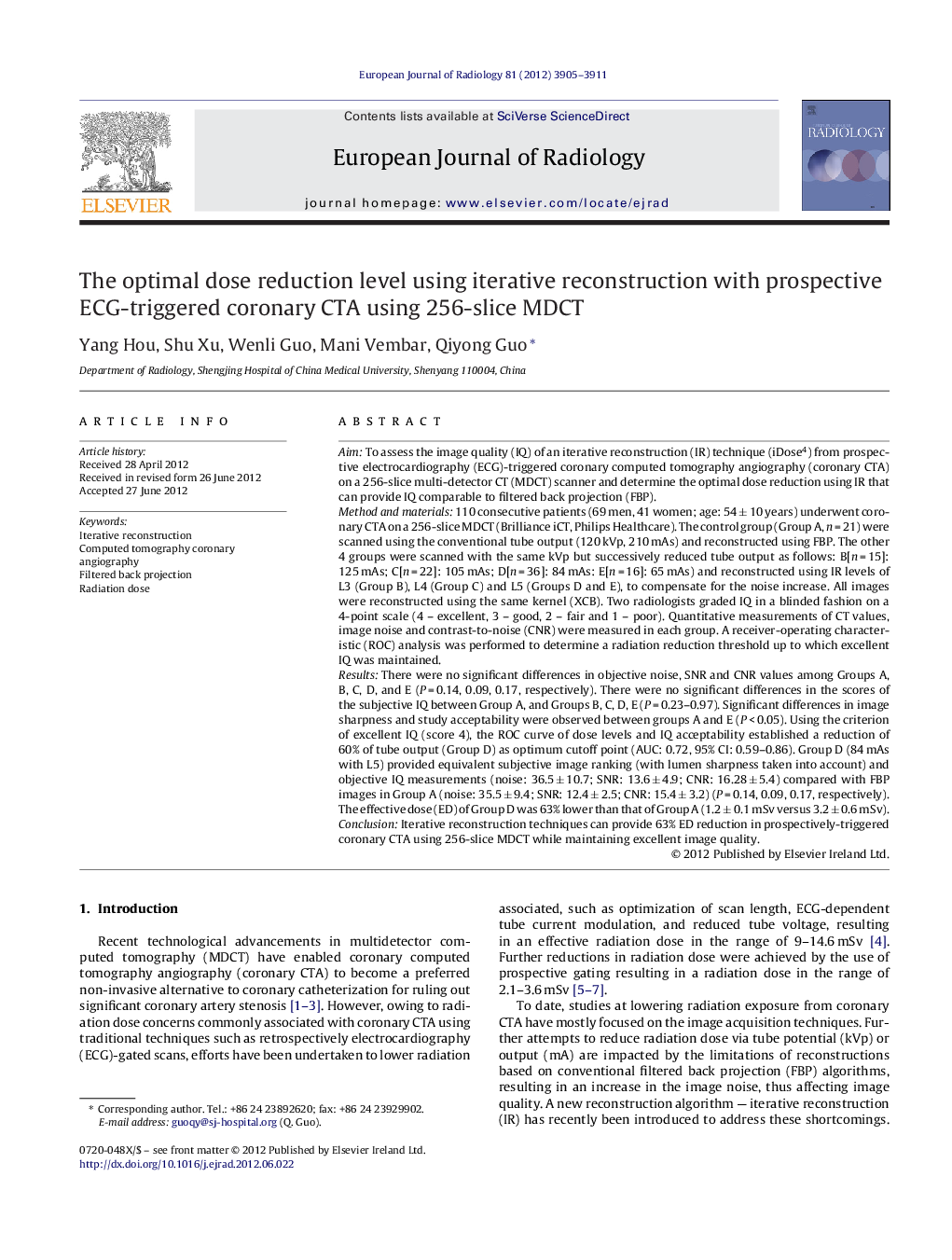| کد مقاله | کد نشریه | سال انتشار | مقاله انگلیسی | نسخه تمام متن |
|---|---|---|---|---|
| 6244758 | 1609783 | 2012 | 7 صفحه PDF | دانلود رایگان |

AimTo assess the image quality (IQ) of an iterative reconstruction (IR) technique (iDose4) from prospective electrocardiography (ECG)-triggered coronary computed tomography angiography (coronary CTA) on a 256-slice multi-detector CT (MDCT) scanner and determine the optimal dose reduction using IR that can provide IQ comparable to filtered back projection (FBP).Method and materials110 consecutive patients (69 men, 41 women; age: 54 ± 10 years) underwent coronary CTA on a 256-slice MDCT (Brilliance iCT, Philips Healthcare). The control group (Group A, n = 21) were scanned using the conventional tube output (120 kVp, 210 mAs) and reconstructed using FBP. The other 4 groups were scanned with the same kVp but successively reduced tube output as follows: B[n = 15]: 125 mAs; C[n = 22]: 105 mAs; D[n = 36]: 84 mAs: E[n = 16]: 65 mAs) and reconstructed using IR levels of L3 (Group B), L4 (Group C) and L5 (Groups D and E), to compensate for the noise increase. All images were reconstructed using the same kernel (XCB). Two radiologists graded IQ in a blinded fashion on a 4-point scale (4 - excellent, 3 - good, 2 - fair and 1 - poor). Quantitative measurements of CT values, image noise and contrast-to-noise (CNR) were measured in each group. A receiver-operating characteristic (ROC) analysis was performed to determine a radiation reduction threshold up to which excellent IQ was maintained.ResultsThere were no significant differences in objective noise, SNR and CNR values among Groups A, B, C, D, and E (P = 0.14, 0.09, 0.17, respectively). There were no significant differences in the scores of the subjective IQ between Group A, and Groups B, C, D, E (P = 0.23-0.97). Significant differences in image sharpness and study acceptability were observed between groups A and E (P < 0.05). Using the criterion of excellent IQ (score 4), the ROC curve of dose levels and IQ acceptability established a reduction of 60% of tube output (Group D) as optimum cutoff point (AUC: 0.72, 95% CI: 0.59-0.86). Group D (84 mAs with L5) provided equivalent subjective image ranking (with lumen sharpness taken into account) and objective IQ measurements (noise: 36.5 ± 10.7; SNR: 13.6 ± 4.9; CNR: 16.28 ± 5.4) compared with FBP images in Group A (noise: 35.5 ± 9.4; SNR: 12.4 ± 2.5; CNR: 15.4 ± 3.2) (P = 0.14, 0.09, 0.17, respectively). The effective dose (ED) of Group D was 63% lower than that of Group A (1.2 ± 0.1 mSv versus 3.2 ± 0.6 mSv).ConclusionIterative reconstruction techniques can provide 63% ED reduction in prospectively-triggered coronary CTA using 256-slice MDCT while maintaining excellent image quality.
Journal: European Journal of Radiology - Volume 81, Issue 12, December 2012, Pages 3905-3911